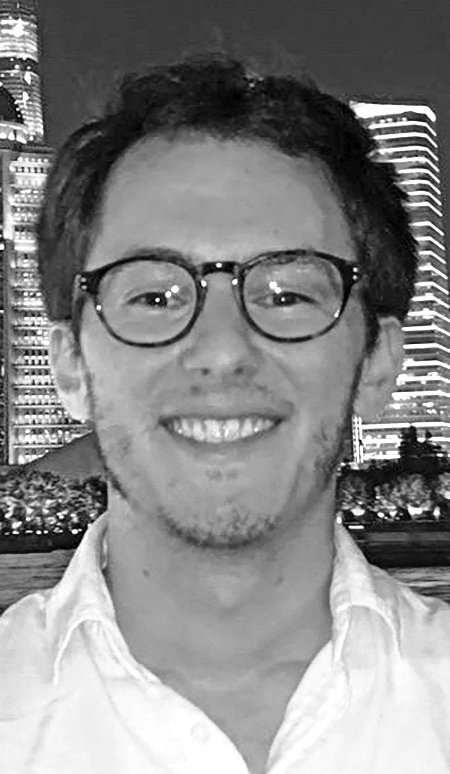Home, safe and sound – and grateful
Shanghai, Jan. 23
The day before the Lunar New Year holiday began in China, I went into my Shanghai office, where I had been working as a consultant for the last 18 months. While at work, I received a breaking news update: the entire city of Wuhan would be sealed off and quarantined to slow the spread of the novel coronavirus.
One of my colleagues contacted a friend in Wuhan, who would be unable to leave the city, and called another friend, who was raised in Wuhan but would not be able to go home. Sealing off a city so large was unprecedented, and was especially shocking so soon before the holiday.
Wearing one of the last N95 masks I had left, which I had on hand for Shanghai’s more polluted days, I left the office and rode the subway to a shopping mall to buy supplies for a holiday trip to Taiwan. I was the only passenger in the subway car, and the mall was almost completely deserted.
All major cities in China typically slow down in advance of the holiday. Shops close and people return to their hometowns. So it was normal to see fewer people out. But even taking that into account, the city felt eerily quiet. Shanghai’s first coronavirus case had been confirmed earlier in the week, and people quickly realized that the outbreak would be at least a national, rather than a regional, crisis.
Taipei, Jan. 30
In the week after I arrived in Taiwan, the number of confirmed coronavirus cases in China increased exponentially, and a growing number of cities and provinces issued “stay at home” orders. In Taipei, the capital of Taiwan, shops seemed to reopen as usual after the Lunar New Year, but on the 30th, I went into seven pharmacies, all of which were already sold out of hand sanitizer. Earlier in the week, I had my temperature taken at the entrance to the National Palace Museum.
Friends and colleagues in Shanghai were holed up at home, and planned to stay there until the city had “flattened the curve,” although I would not hear that exact phrasing for another month, and in another part of the world. There was deep concern and anxiety over how quickly the coronavirus ground life to a halt across China, and much solidarity with Wuhan, where the outbreak was most severe. This was evident online, and friends said the same.
The virus blanketed the news in Taiwan and was the leading topic of conversation, but all the tourist sites on my itinerary remained open. With fewer than 10 confirmed cases in the nation, I had yet to hear anyone urge social distancing. I was grateful to be there, instead of quarantined alone in my Shanghai apartment.
New York City, Feb. 2
I disembarked at John F. Kennedy airport on the evening of the Super Bowl, with around 300 other passengers – all of us wearing masks. When most people around you are wearing a mask, choosing to join them does more than contain the spread of a virus: It gives you a sense of camaraderie, and indicates to those around you that you take the situation seriously.
The 14-hour flight was not enough to describe the distance we had traveled. As we followed signs for customs, we merged with passengers from other flights. Some who saw our masks gazed at us suspiciously. It had been 12 days since the first coronavirus case was confirmed in the United States. The virus was here in America, but for too many, the threat did not yet seem real.
While my flight was in the air, the U.S. Department of Homeland Security announced that all direct inbound flights from China would be routed to eight airports, JFK included. In the terminal, I found Customs and Border Protection staff scrambling to adjust to changing regulations, while some expressed confusion over how to handle flights from Taiwan. After more than an hour of questioning (have you been to Wuhan? What about Hubei?), I was cleared to leave. No one took my temperature or recommended that I self-isolate.
Providence, March 11
As the 1,000th coronavirus case in the U.S. was confirmed, President Donald Trump gave an Oval Office address. I had already been concerned about how badly the U.S. might be impacted, knowing how rapidly the virus had spread in China. Soon after that address, more people began to share that concern.
Friends around the country were telling me that they’d been instructed to work from home, while others lost their jobs altogether. Seemingly everyone began using Zoom, while “social distancing” entered our parlance and restaurants transitioned to take-out and delivery only.
I avoided quarantining in Shanghai by opting to fly to the U.S. from Taiwan, only to find myself in a similar situation in Providence just weeks later. Back in January, reading the news from Wuhan was heartbreaking, and imagining Providence as empty as Shanghai seemed impossible. But trying to do so helped me empathize with people here whose lives had been flipped completely upside down.
Today, an outbreak here is the reality, no imagination required. The number of cases in the U.S. has grown more than 100 times over since the president’s address, and the situation is undoubtedly as serious here now as it was in China in February.
China announced at the end of March that it would be barring all non-citizens from reentry, including those with valid residence permits, like myself, meaning I have no way back to Shanghai for the foreseeable future. But despite these extreme circumstances, I have much to be grateful for.
DAVID BRENMAN grew up in Providence and has lived in China for three years.








